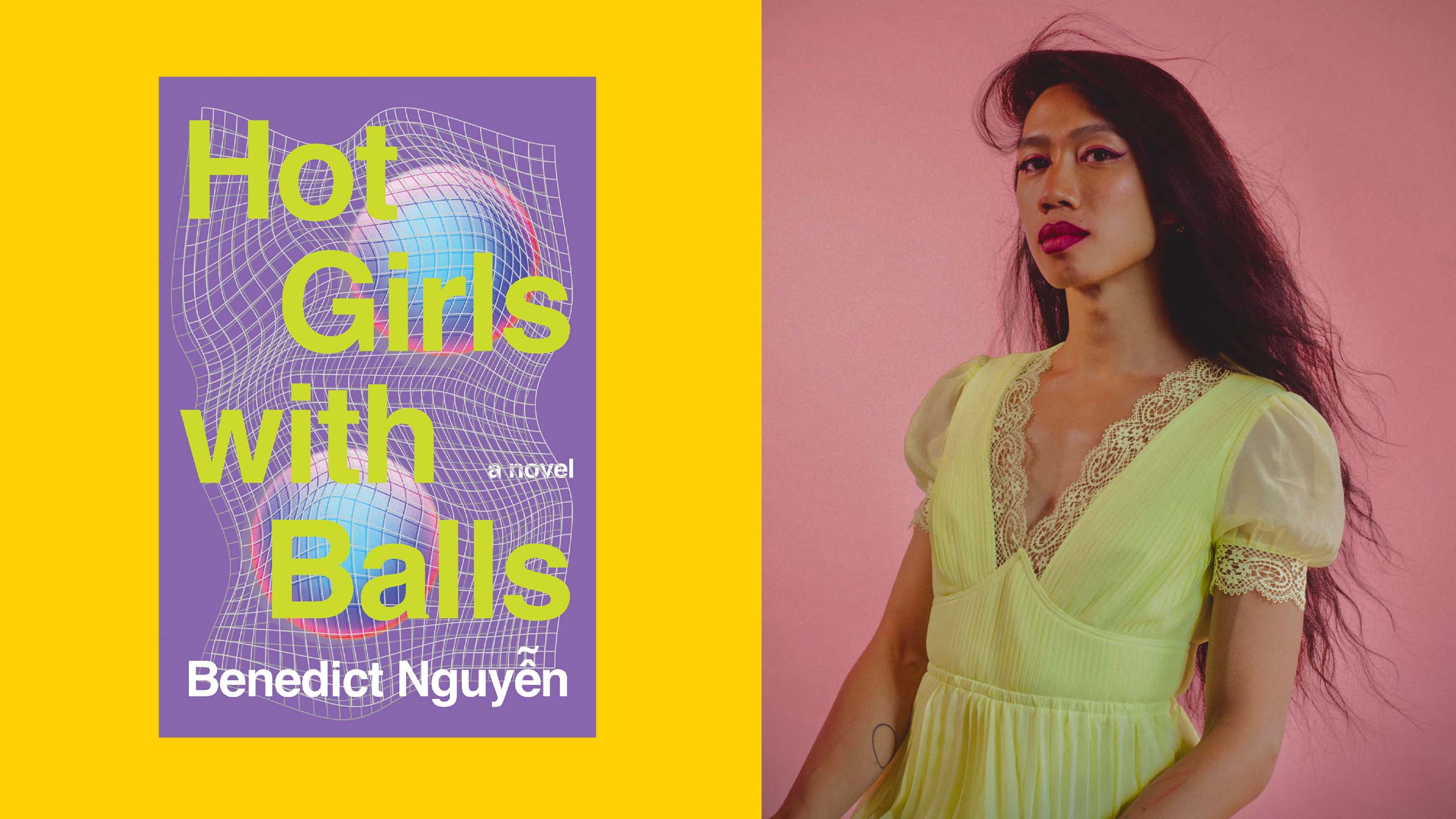Midway through Benedict Nguyễn’s propulsive trans volleyball novel, Hot Girls with Balls, Six, one of the book’s two heroines, struggles with mounting nerves as she prepares to play an important match. She is less worried about the actual gameplay than she is about the performance of her public persona, which she knows will be screencapped, shared and dissected by fans and haters alike: “For what sports arena was not also a theatre?”
Six and Green are the larger-than-life protagonists of Nguyễn’s dizzying satire. The two are both “very hot” Asian American trans women who play in a fictional men’s global volleyball league; they work tirelessly, not just in their volleyball training sessions, but also to curate and maintain their social media star status. Six and Green, who are also very publicly dating each other, are as canny and self-aware as they are hot—they know that their athletic careers depend just as much on their ability to bring in brand deals by amassing more and more followers, as on their prowess on the volleyball court. Hot Girls with Balls brims with charisma, envy, sabotage and taut, taut muscles. You don’t have to be a sports fan to be utterly compelled by Nguyễn’s vision—and to become just as obsessed with Six and Green as their fictional followers are.
Nguyễn’s knack for recreating the chaotic, hate-it-but-can’t-look-away nature of online discourse makes this, her debut novel, a text in perpetual motion. She is an athlete herself—a dancer and self-professed gym buff—and writes as deftly about the stresses, training regimens and team choreography of competitive sports as she does about the micro-details of being trans in the public eye. Hot Girls with Balls is an expertly structured text, its central narrative arc intercut and propelled by scrolls of livestream and forum comments from Six’s and Green’s supporters and enemies. Reading it is a dizzying experience, as overwhelming as scrolling through a constantly updating online comment section, while straining to follow the various polarized arguments that are being thrown around. Six and Green have taken the sports world by storm, showing volleyball fans that the game “wasn’t just balls but endless unspoken feeling filtering back and forth across the net.” Nguyễn crafts a text that mimics this emotional back-and-forth—the novel darts between the perspectives of our two star players as they train for a major tournament; curate their online personas; publicly manage their romantic relationship; navigate brand deals, media appearances, blatant transphobia, obsessive adulation and the pitfalls of solidarity and visibility discourse.
The story is set in 2021, in a parallel universe that closely resembles our own. In this universe, COVID is “COVIS,” and people spend their pandemic lockdowns online on Flitter, Instagraph, SpaceTime, LonelyFans, Seddit and Discard. Most importantly, volleyball is a ragingly popular international sport, with an annual tech-bro-sponsored international tournament and commentators who discuss the players as if they are reality TV characters. Six and Green, who each have hundreds of thousands of online followers, are both at the peaks of their athletic careers; they are also online celebrities, and have recently started cashing in on their romantic relationship by premiering a livestreamed weekly show, attracting tens of thousands of viewers. At the novel’s outset, our two heroines, who have been kept apart by the rigorous training schedules of their respective teams, are excited to finally spend some time together at the Sonus Volleyball Tournament. They long for some intimate time, after months of managing their long-distance relationship via daily “SpaceTime” calls. But even when they are finally in the same hotel and practising in the same arena, the demands of their online celebrity status threaten to tear them apart: “lover time had been subsumed by girlboss time.”
When three Asian American trans women are murdered in a hotel room in an American city, Six and Green are divided over whether they should make a public statement or not. Is it worse to risk making someone else’s tragedy all about them, or to stay silent and appear to be uncaring and lacking in solidarity? Soon afterward, as the tournament nears its final match, a secret enemy of the couple leaks some explosive private content, and Six and Green are tested even further. Their relationship and their personal integrity are threatened by the emotional impact of the ensuing online vitriol, from both anti-trans instigators and within the trans community itself, alongside the mounting pressure to perform inauthentic, marketable versions of themselves.
Hot Girls with Balls is the most online novel I’ve ever read, besides Patricia Lockwood’s No One Is Talking About This, the 2021 novel that astutely captured a pre-COVID era Twitter that already feels archaic in 2025. Both novels interrogate the churning, never-ending noise of 2020s social media discourse by adopting the rhythms and tones of that discourse. Before these more recent texts came Dennis Cooper’s equal parts funny and terrifying novel The Sluts, a noir mystery narrated mainly via posts on a gay escort website. Published in 2004, The Sluts’ use of invented ads and online comments—including horny, often violent reviews of the escorts and what people have done with them or to them, draws the reader deeper and deeper into its narrative of shifting relationships and possible murder. The reader is pulled into a form of voyeuristic complicity—just like the fictional posters in the escort forums, we can’t stop reading the profiles of underage boy sex workers and the comments of their johns, desperate to find out what new violence has been committed and by whom. Hot Girls with Balls plays with a similar dynamic—as a reader, just like the fans and haters in Six’s and Green’s comments, I became obsessed with gleaning details of the couple’s intimate lives, which Nguyễn offers sparingly. Like the fictional online public of Nguyễn’s novel, the book’s audience must try to pick out a central narrative from the anonymous comment threads, by parsing the legitimacy of each shared opinion and statement. In doing so, the reader risks becoming subsumed by the relentless noise of the fictional online fandom/haters. It is tempting to feel superior to the anonymous commenters in the text, because the reader has the advantage of accessing intimate scenes between Six and Green that occur when the athletes’ cameras are off—but this sense of superiority, of having more access to these two women than their internet fandom has, uncomfortably mimics the attitudes of their obsessive followers.
The blurry lines between the real and the fake, between complicity and allyship are a constant source of tension in Hot Girls with Balls. Six, who is less ambitious than Green, but also has more followers, especially struggles with the particular pressures of being a racialized trans woman celebrity. Both women are always watched, always analyzed and dissected, from the way they spike a ball, to how their bodies look in various garments, to what kind of sex they have and what their genitals look like, to the political stances that they take or do not take. “Did she perform for the public or did the public perform her for itself?” Six wonders, exhausted after a particularly stressful tournament match. She and Green are required to play in the men’s volleyball league, despite both having come out as trans women a decade earlier: “Biology and bigotry were insurmountable made-up forces.” The fact that neither of them has transitioned medically attracts online admirers, fetishists and haters of all kinds, from TERFs to transmedicalists to run-of-the-mill bigots and racists. On their Instagraph livestreams, the variety of comments rolling in is enough to cause emotional whiplash: “The virus [COVIS] won’t kill me but this video of Six dancing in a racer back tank top might”; “This is what happens when Asian American masculinity keeps getting threatened by the liberal agenda”; “How can two sick people play volleyball so good?”; “Please Six, just marry me!! If not, just spike a ball into my face, please, I’ll pay!”; “How can they be dudes who are women who are lesbians who are into dudes and play on the men’s team?” Slow motion GIFs and closeups of their asses, wrists, ankles and legs proliferate.
The cost of this hypervisibility begins to worry Six after the three women are murdered. She examines her arm veins in the mirror, worried that they are protruding too much: “Would somebody try to kill her?” Green is determined to make a public post about the murders, unwilling to hide her grief, but also motivated by an uglier desire—to gain more popularity via a perfectly worded statement of allyship. Neither of Green’s dual intentions are inauthentic; instead, they coexist in an uncomfortable frictional space that will be familiar to most people who spend any time promoting themselves, their art, their businesses or their athletic achievements online during this era of mounting violence and insecurity. Hot Girls with Balls examines and refracts this friction, with a mix of hilarity and deadly seriousness.
Nguyễn has written a polyphonic, tender, biting novel, with two fascinating trans heroines at its centre. Six and Green feel so real that you might find yourself searching for their handles on socials once you’ve finished reading, hoping for just one more glimpse of the trophy-winning, ponytail-wielding volleyball stars.


 Why you can trust Xtra
Why you can trust Xtra


